Case Study: Analyzing Ethical and Non-Ethical Issues in QA Testing
VerifiedAdded on 2020/02/24
|10
|2115
|114
Case Study
AI Summary
This report presents a case study focusing on the ethical and non-ethical challenges faced by a Quality Assurance (QA) testing group within a company. The scenario involves the QA team deciding to deliver a system without conducting proper testing, raising concerns about customer trust and product quality. The report delves into the facts of the situation, identifies non-ethical issues such as misleading customers and potential damage to the company's reputation, and analyzes the ethical implications, particularly regarding the responsibilities of the QA group and the development team. It explores the impact on stakeholders, including customers, the development team, and the team leader. The report suggests potential solutions, such as the team leader intervening to ensure proper testing. The best option, according to the analysis, is the team leader's intervention to enforce testing protocols. The report concludes by emphasizing the importance of ethical practices in maintaining business integrity and ensuring customer satisfaction. References to relevant literature are also included.
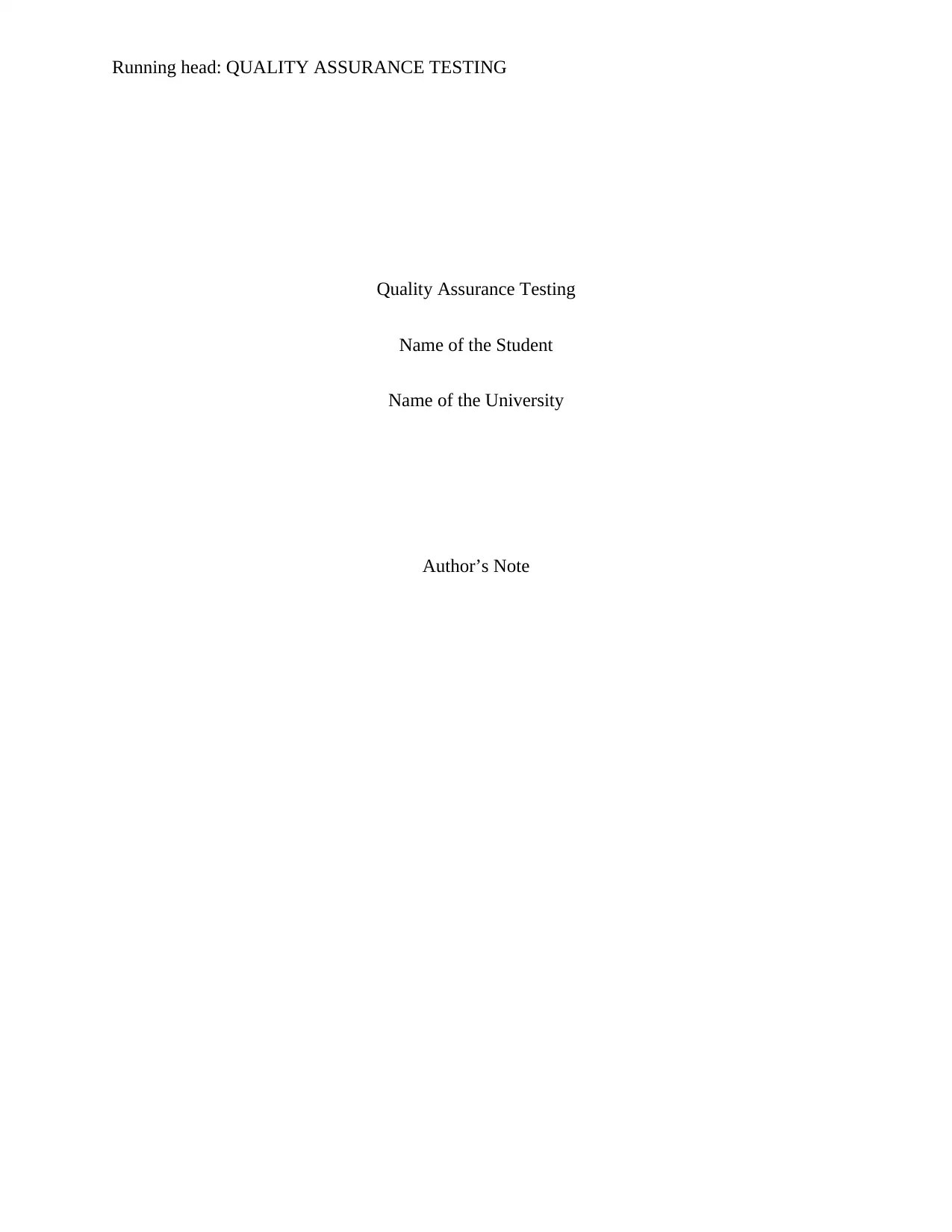
Running head: QUALITY ASSURANCE TESTING
Quality Assurance Testing
Name of the Student
Name of the University
Author’s Note
Quality Assurance Testing
Name of the Student
Name of the University
Author’s Note
Paraphrase This Document
Need a fresh take? Get an instant paraphrase of this document with our AI Paraphraser
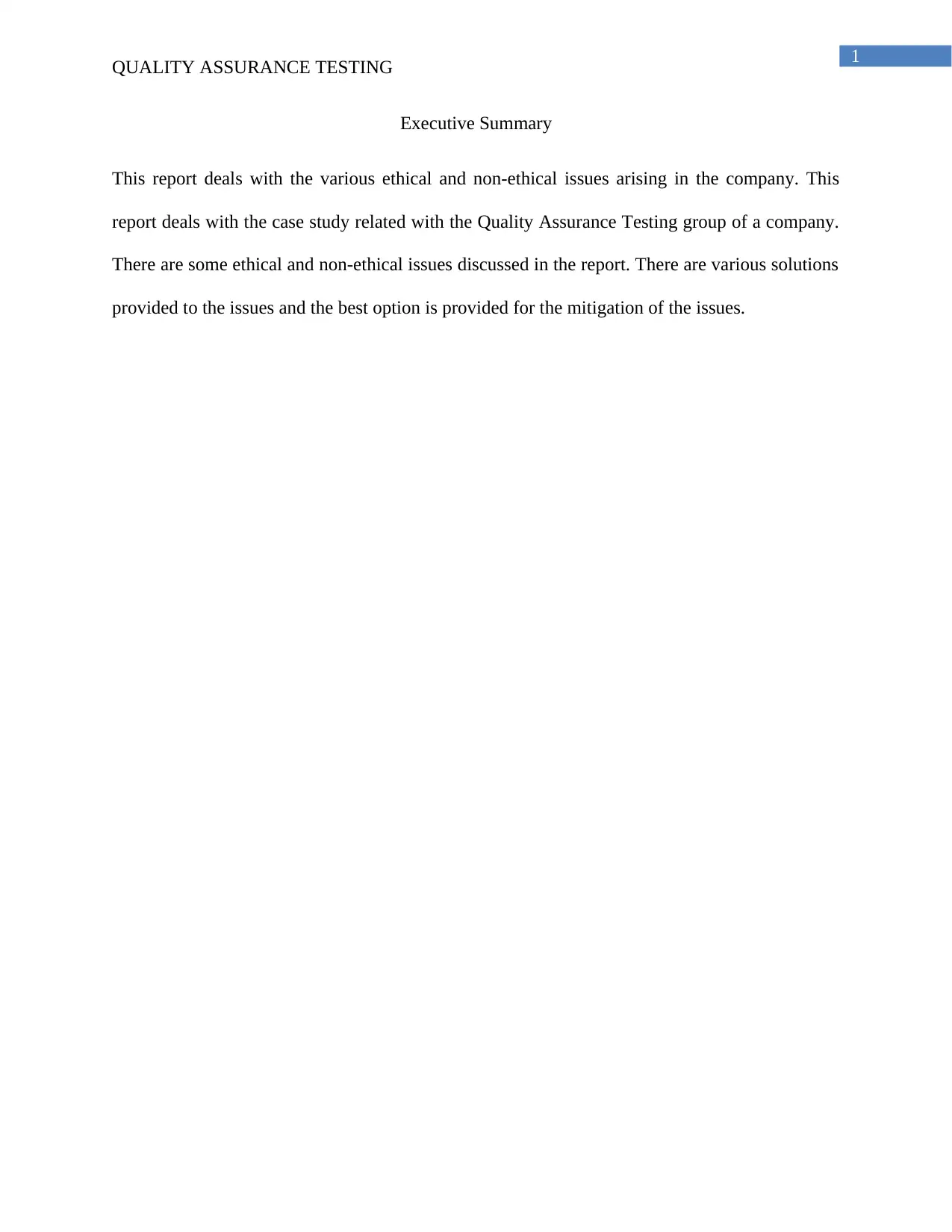
1
QUALITY ASSURANCE TESTING
Executive Summary
This report deals with the various ethical and non-ethical issues arising in the company. This
report deals with the case study related with the Quality Assurance Testing group of a company.
There are some ethical and non-ethical issues discussed in the report. There are various solutions
provided to the issues and the best option is provided for the mitigation of the issues.
QUALITY ASSURANCE TESTING
Executive Summary
This report deals with the various ethical and non-ethical issues arising in the company. This
report deals with the case study related with the Quality Assurance Testing group of a company.
There are some ethical and non-ethical issues discussed in the report. There are various solutions
provided to the issues and the best option is provided for the mitigation of the issues.
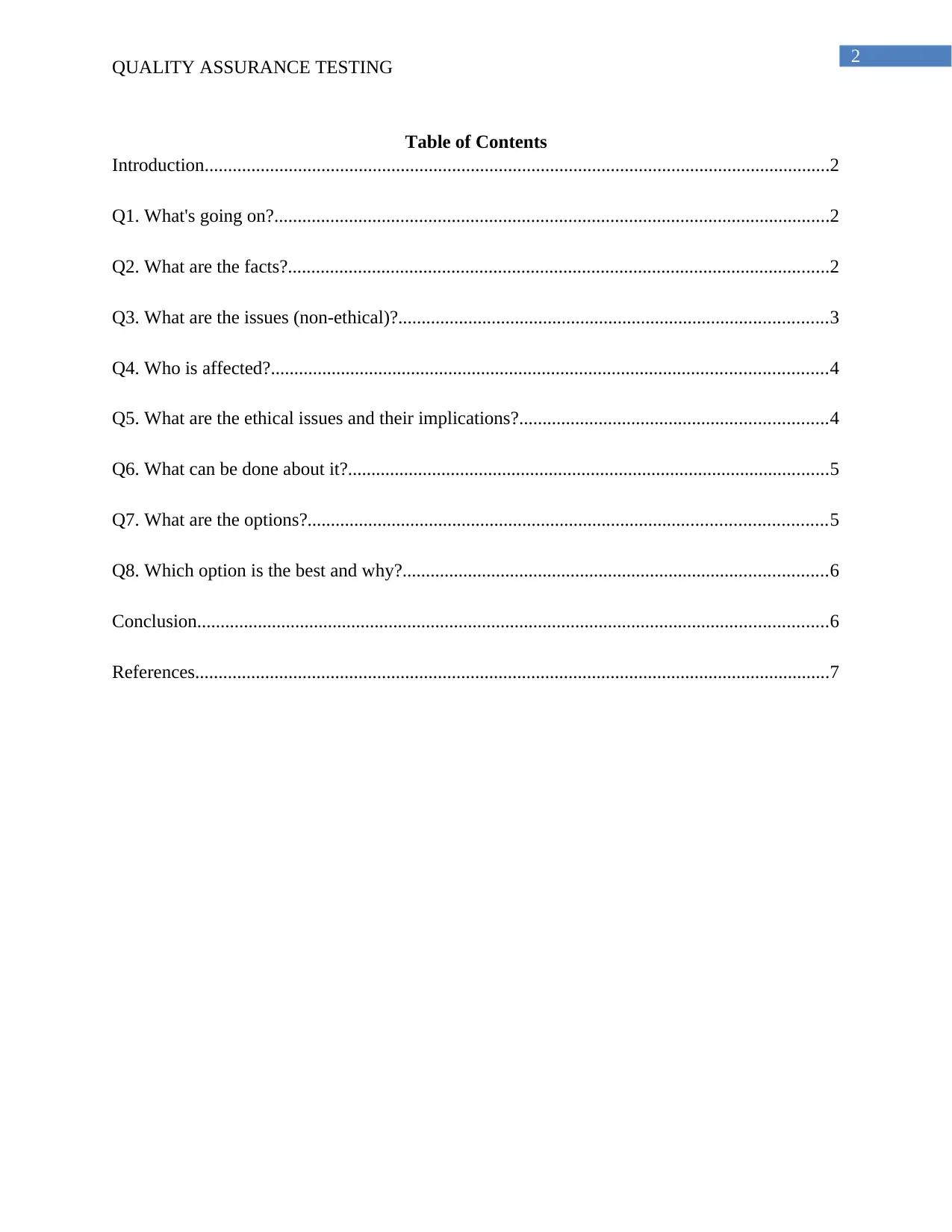
2
QUALITY ASSURANCE TESTING
Table of Contents
Introduction......................................................................................................................................2
Q1. What's going on?.......................................................................................................................2
Q2. What are the facts?....................................................................................................................2
Q3. What are the issues (non-ethical)?............................................................................................3
Q4. Who is affected?.......................................................................................................................4
Q5. What are the ethical issues and their implications?..................................................................4
Q6. What can be done about it?.......................................................................................................5
Q7. What are the options?...............................................................................................................5
Q8. Which option is the best and why?...........................................................................................6
Conclusion.......................................................................................................................................6
References........................................................................................................................................7
QUALITY ASSURANCE TESTING
Table of Contents
Introduction......................................................................................................................................2
Q1. What's going on?.......................................................................................................................2
Q2. What are the facts?....................................................................................................................2
Q3. What are the issues (non-ethical)?............................................................................................3
Q4. Who is affected?.......................................................................................................................4
Q5. What are the ethical issues and their implications?..................................................................4
Q6. What can be done about it?.......................................................................................................5
Q7. What are the options?...............................................................................................................5
Q8. Which option is the best and why?...........................................................................................6
Conclusion.......................................................................................................................................6
References........................................................................................................................................7
⊘ This is a preview!⊘
Do you want full access?
Subscribe today to unlock all pages.

Trusted by 1+ million students worldwide
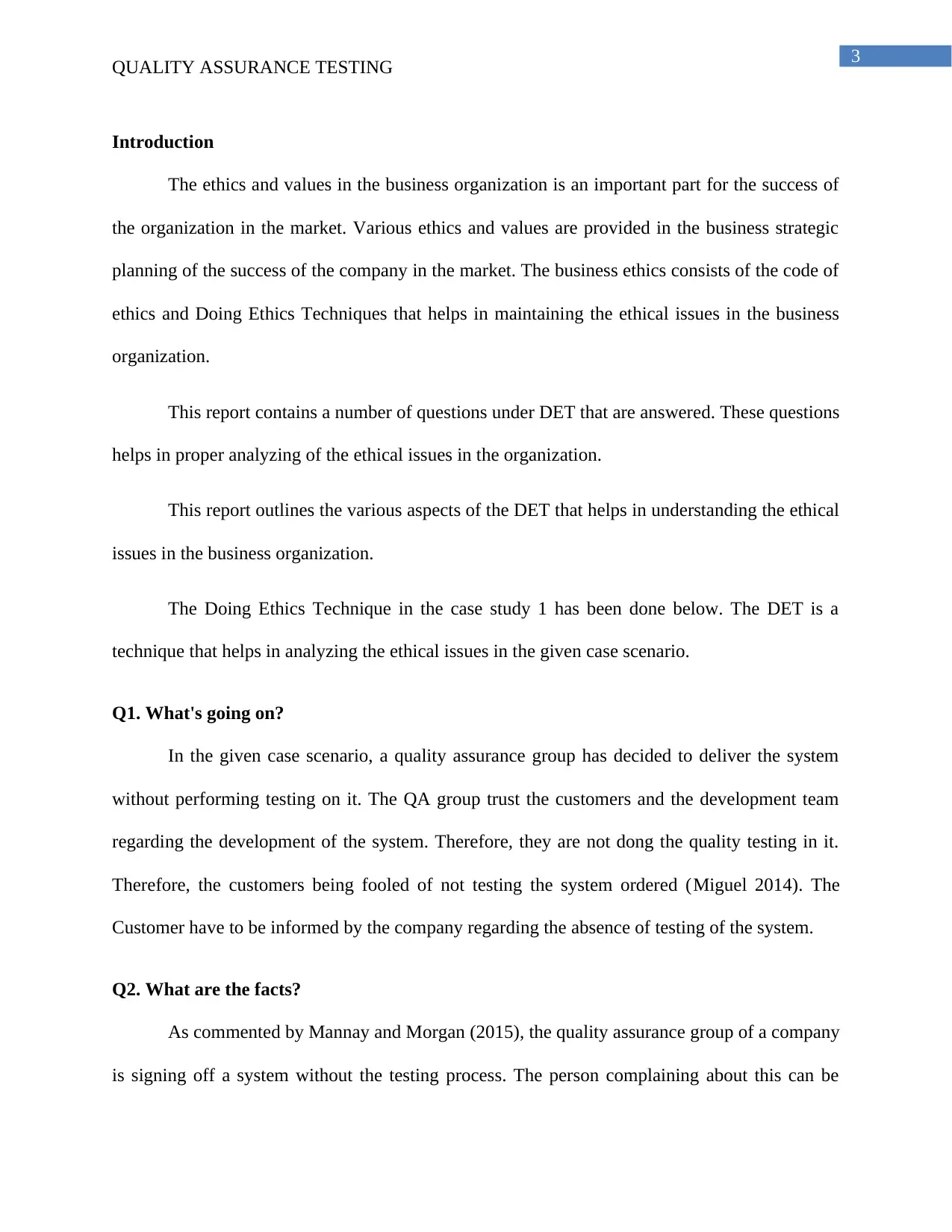
3
QUALITY ASSURANCE TESTING
Introduction
The ethics and values in the business organization is an important part for the success of
the organization in the market. Various ethics and values are provided in the business strategic
planning of the success of the company in the market. The business ethics consists of the code of
ethics and Doing Ethics Techniques that helps in maintaining the ethical issues in the business
organization.
This report contains a number of questions under DET that are answered. These questions
helps in proper analyzing of the ethical issues in the organization.
This report outlines the various aspects of the DET that helps in understanding the ethical
issues in the business organization.
The Doing Ethics Technique in the case study 1 has been done below. The DET is a
technique that helps in analyzing the ethical issues in the given case scenario.
Q1. What's going on?
In the given case scenario, a quality assurance group has decided to deliver the system
without performing testing on it. The QA group trust the customers and the development team
regarding the development of the system. Therefore, they are not dong the quality testing in it.
Therefore, the customers being fooled of not testing the system ordered (Miguel 2014). The
Customer have to be informed by the company regarding the absence of testing of the system.
Q2. What are the facts?
As commented by Mannay and Morgan (2015), the quality assurance group of a company
is signing off a system without the testing process. The person complaining about this can be
QUALITY ASSURANCE TESTING
Introduction
The ethics and values in the business organization is an important part for the success of
the organization in the market. Various ethics and values are provided in the business strategic
planning of the success of the company in the market. The business ethics consists of the code of
ethics and Doing Ethics Techniques that helps in maintaining the ethical issues in the business
organization.
This report contains a number of questions under DET that are answered. These questions
helps in proper analyzing of the ethical issues in the organization.
This report outlines the various aspects of the DET that helps in understanding the ethical
issues in the business organization.
The Doing Ethics Technique in the case study 1 has been done below. The DET is a
technique that helps in analyzing the ethical issues in the given case scenario.
Q1. What's going on?
In the given case scenario, a quality assurance group has decided to deliver the system
without performing testing on it. The QA group trust the customers and the development team
regarding the development of the system. Therefore, they are not dong the quality testing in it.
Therefore, the customers being fooled of not testing the system ordered (Miguel 2014). The
Customer have to be informed by the company regarding the absence of testing of the system.
Q2. What are the facts?
As commented by Mannay and Morgan (2015), the quality assurance group of a company
is signing off a system without the testing process. The person complaining about this can be
Paraphrase This Document
Need a fresh take? Get an instant paraphrase of this document with our AI Paraphraser
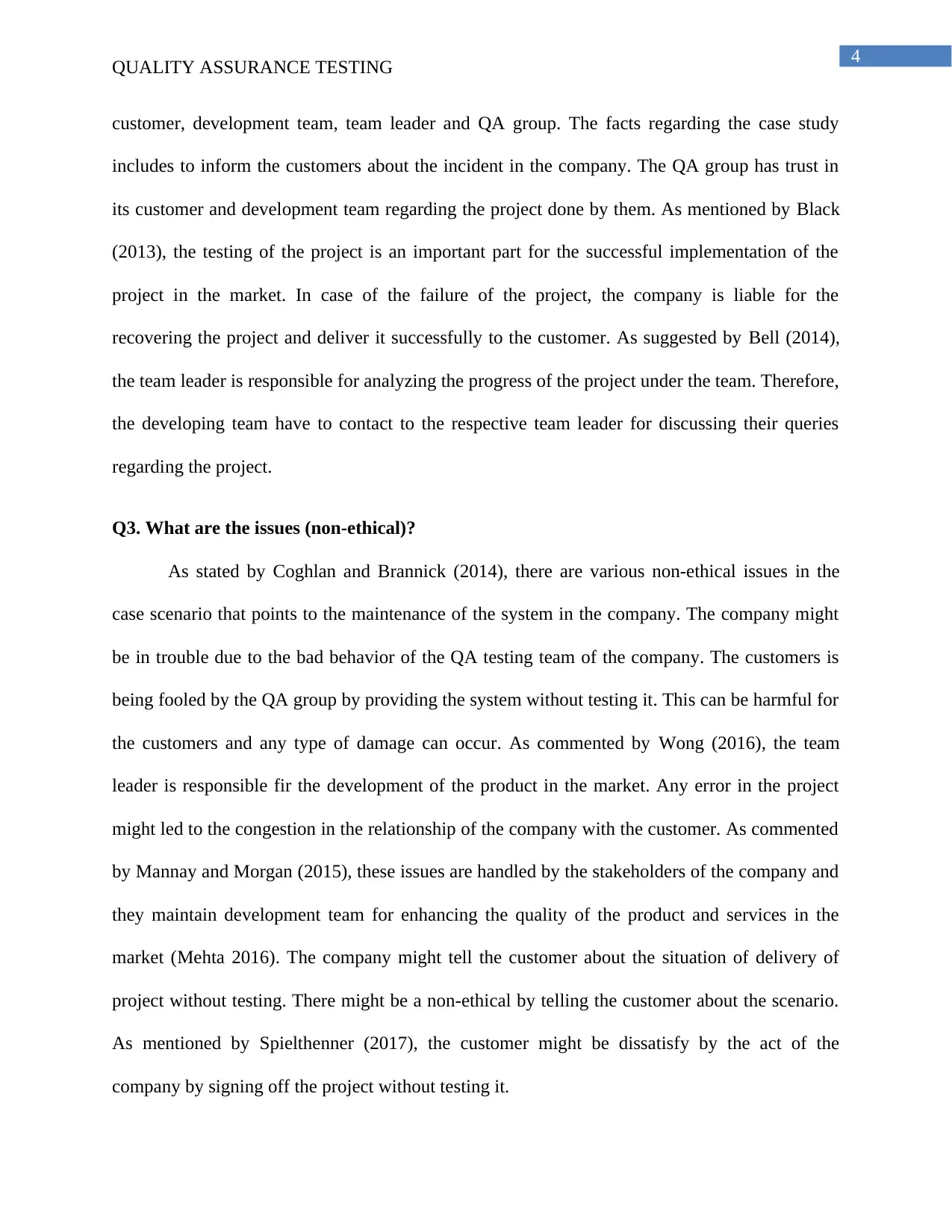
4
QUALITY ASSURANCE TESTING
customer, development team, team leader and QA group. The facts regarding the case study
includes to inform the customers about the incident in the company. The QA group has trust in
its customer and development team regarding the project done by them. As mentioned by Black
(2013), the testing of the project is an important part for the successful implementation of the
project in the market. In case of the failure of the project, the company is liable for the
recovering the project and deliver it successfully to the customer. As suggested by Bell (2014),
the team leader is responsible for analyzing the progress of the project under the team. Therefore,
the developing team have to contact to the respective team leader for discussing their queries
regarding the project.
Q3. What are the issues (non-ethical)?
As stated by Coghlan and Brannick (2014), there are various non-ethical issues in the
case scenario that points to the maintenance of the system in the company. The company might
be in trouble due to the bad behavior of the QA testing team of the company. The customers is
being fooled by the QA group by providing the system without testing it. This can be harmful for
the customers and any type of damage can occur. As commented by Wong (2016), the team
leader is responsible fir the development of the product in the market. Any error in the project
might led to the congestion in the relationship of the company with the customer. As commented
by Mannay and Morgan (2015), these issues are handled by the stakeholders of the company and
they maintain development team for enhancing the quality of the product and services in the
market (Mehta 2016). The company might tell the customer about the situation of delivery of
project without testing. There might be a non-ethical by telling the customer about the scenario.
As mentioned by Spielthenner (2017), the customer might be dissatisfy by the act of the
company by signing off the project without testing it.
QUALITY ASSURANCE TESTING
customer, development team, team leader and QA group. The facts regarding the case study
includes to inform the customers about the incident in the company. The QA group has trust in
its customer and development team regarding the project done by them. As mentioned by Black
(2013), the testing of the project is an important part for the successful implementation of the
project in the market. In case of the failure of the project, the company is liable for the
recovering the project and deliver it successfully to the customer. As suggested by Bell (2014),
the team leader is responsible for analyzing the progress of the project under the team. Therefore,
the developing team have to contact to the respective team leader for discussing their queries
regarding the project.
Q3. What are the issues (non-ethical)?
As stated by Coghlan and Brannick (2014), there are various non-ethical issues in the
case scenario that points to the maintenance of the system in the company. The company might
be in trouble due to the bad behavior of the QA testing team of the company. The customers is
being fooled by the QA group by providing the system without testing it. This can be harmful for
the customers and any type of damage can occur. As commented by Wong (2016), the team
leader is responsible fir the development of the product in the market. Any error in the project
might led to the congestion in the relationship of the company with the customer. As commented
by Mannay and Morgan (2015), these issues are handled by the stakeholders of the company and
they maintain development team for enhancing the quality of the product and services in the
market (Mehta 2016). The company might tell the customer about the situation of delivery of
project without testing. There might be a non-ethical by telling the customer about the scenario.
As mentioned by Spielthenner (2017), the customer might be dissatisfy by the act of the
company by signing off the project without testing it.
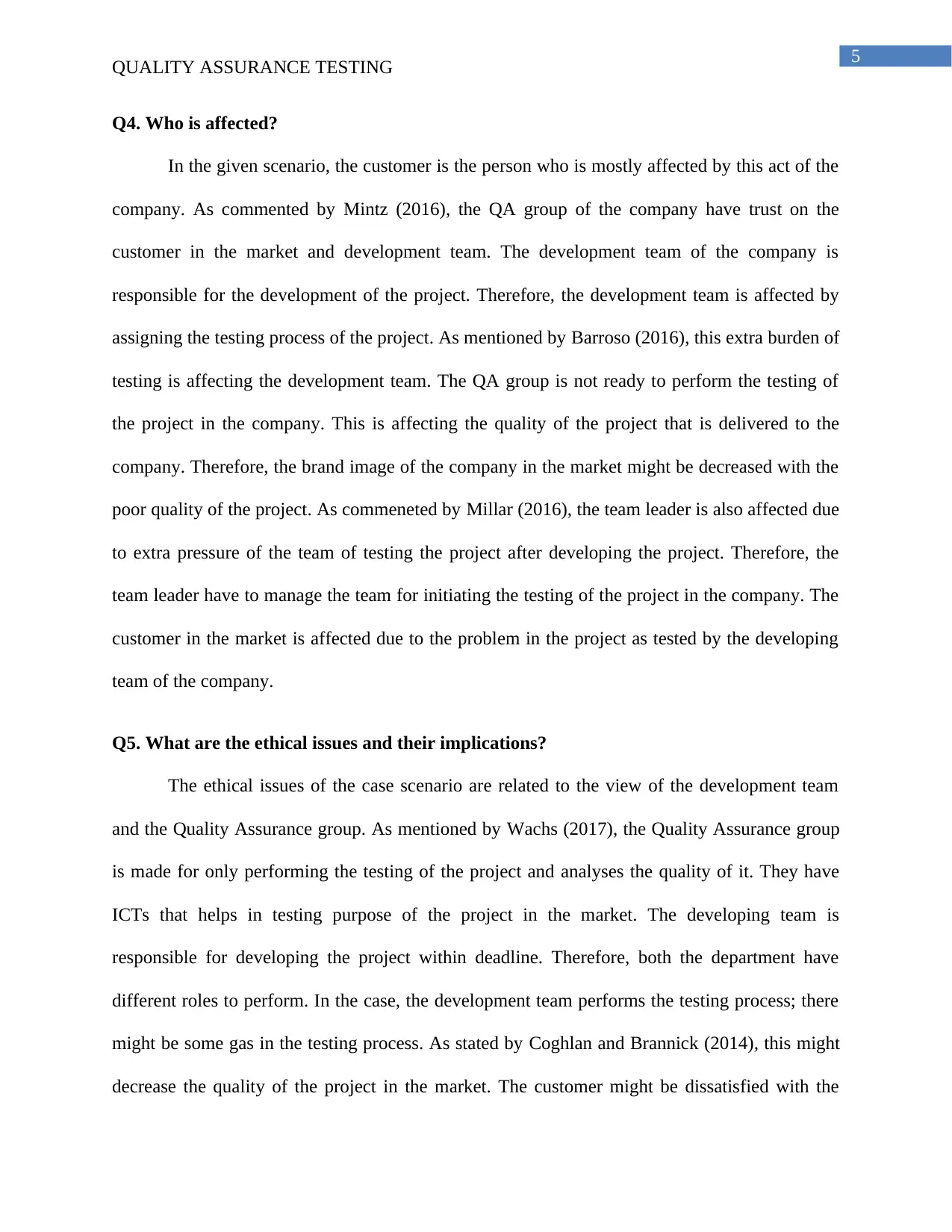
5
QUALITY ASSURANCE TESTING
Q4. Who is affected?
In the given scenario, the customer is the person who is mostly affected by this act of the
company. As commented by Mintz (2016), the QA group of the company have trust on the
customer in the market and development team. The development team of the company is
responsible for the development of the project. Therefore, the development team is affected by
assigning the testing process of the project. As mentioned by Barroso (2016), this extra burden of
testing is affecting the development team. The QA group is not ready to perform the testing of
the project in the company. This is affecting the quality of the project that is delivered to the
company. Therefore, the brand image of the company in the market might be decreased with the
poor quality of the project. As commeneted by Millar (2016), the team leader is also affected due
to extra pressure of the team of testing the project after developing the project. Therefore, the
team leader have to manage the team for initiating the testing of the project in the company. The
customer in the market is affected due to the problem in the project as tested by the developing
team of the company.
Q5. What are the ethical issues and their implications?
The ethical issues of the case scenario are related to the view of the development team
and the Quality Assurance group. As mentioned by Wachs (2017), the Quality Assurance group
is made for only performing the testing of the project and analyses the quality of it. They have
ICTs that helps in testing purpose of the project in the market. The developing team is
responsible for developing the project within deadline. Therefore, both the department have
different roles to perform. In the case, the development team performs the testing process; there
might be some gas in the testing process. As stated by Coghlan and Brannick (2014), this might
decrease the quality of the project in the market. The customer might be dissatisfied with the
QUALITY ASSURANCE TESTING
Q4. Who is affected?
In the given scenario, the customer is the person who is mostly affected by this act of the
company. As commented by Mintz (2016), the QA group of the company have trust on the
customer in the market and development team. The development team of the company is
responsible for the development of the project. Therefore, the development team is affected by
assigning the testing process of the project. As mentioned by Barroso (2016), this extra burden of
testing is affecting the development team. The QA group is not ready to perform the testing of
the project in the company. This is affecting the quality of the project that is delivered to the
company. Therefore, the brand image of the company in the market might be decreased with the
poor quality of the project. As commeneted by Millar (2016), the team leader is also affected due
to extra pressure of the team of testing the project after developing the project. Therefore, the
team leader have to manage the team for initiating the testing of the project in the company. The
customer in the market is affected due to the problem in the project as tested by the developing
team of the company.
Q5. What are the ethical issues and their implications?
The ethical issues of the case scenario are related to the view of the development team
and the Quality Assurance group. As mentioned by Wachs (2017), the Quality Assurance group
is made for only performing the testing of the project and analyses the quality of it. They have
ICTs that helps in testing purpose of the project in the market. The developing team is
responsible for developing the project within deadline. Therefore, both the department have
different roles to perform. In the case, the development team performs the testing process; there
might be some gas in the testing process. As stated by Coghlan and Brannick (2014), this might
decrease the quality of the project in the market. The customer might be dissatisfied with the
⊘ This is a preview!⊘
Do you want full access?
Subscribe today to unlock all pages.

Trusted by 1+ million students worldwide
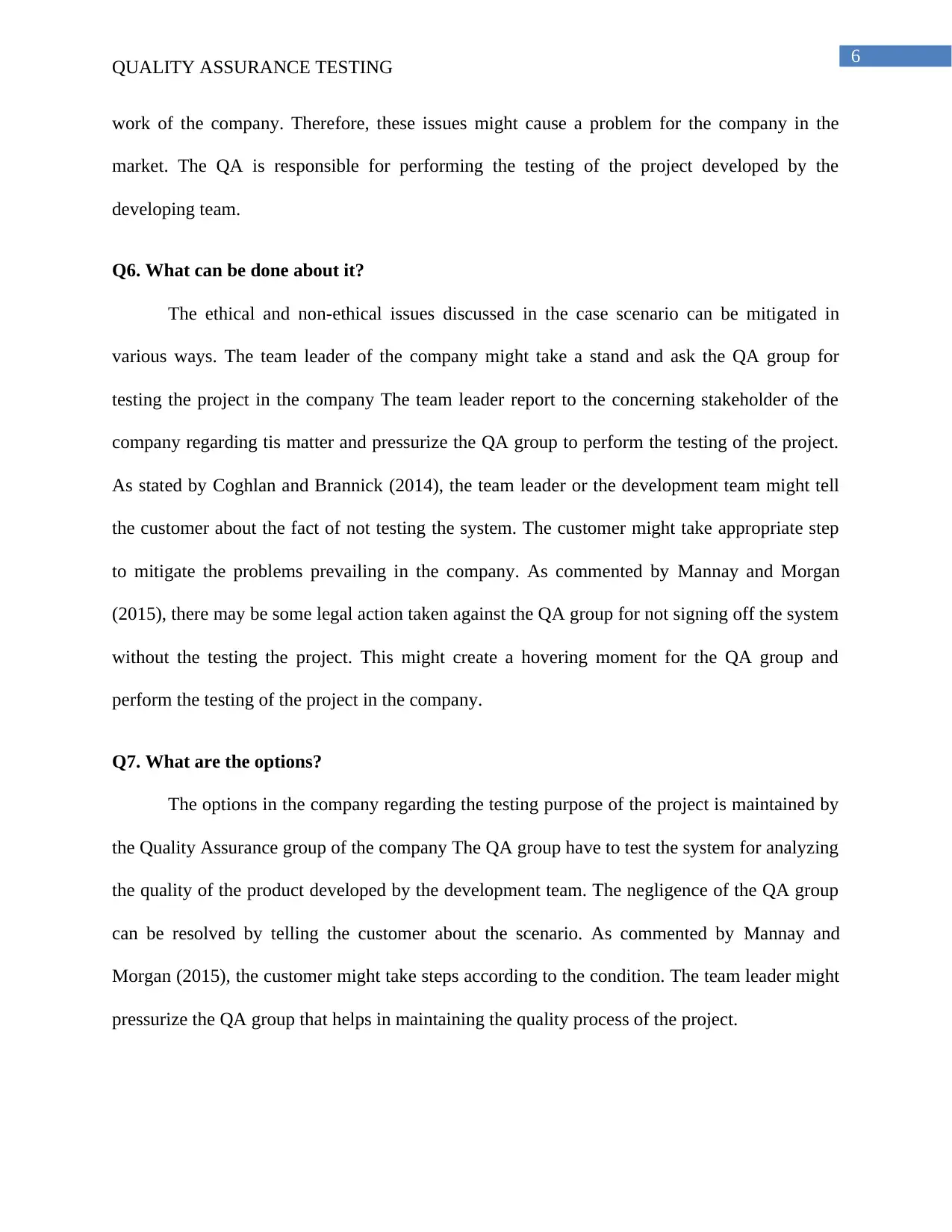
6
QUALITY ASSURANCE TESTING
work of the company. Therefore, these issues might cause a problem for the company in the
market. The QA is responsible for performing the testing of the project developed by the
developing team.
Q6. What can be done about it?
The ethical and non-ethical issues discussed in the case scenario can be mitigated in
various ways. The team leader of the company might take a stand and ask the QA group for
testing the project in the company The team leader report to the concerning stakeholder of the
company regarding tis matter and pressurize the QA group to perform the testing of the project.
As stated by Coghlan and Brannick (2014), the team leader or the development team might tell
the customer about the fact of not testing the system. The customer might take appropriate step
to mitigate the problems prevailing in the company. As commented by Mannay and Morgan
(2015), there may be some legal action taken against the QA group for not signing off the system
without the testing the project. This might create a hovering moment for the QA group and
perform the testing of the project in the company.
Q7. What are the options?
The options in the company regarding the testing purpose of the project is maintained by
the Quality Assurance group of the company The QA group have to test the system for analyzing
the quality of the product developed by the development team. The negligence of the QA group
can be resolved by telling the customer about the scenario. As commented by Mannay and
Morgan (2015), the customer might take steps according to the condition. The team leader might
pressurize the QA group that helps in maintaining the quality process of the project.
QUALITY ASSURANCE TESTING
work of the company. Therefore, these issues might cause a problem for the company in the
market. The QA is responsible for performing the testing of the project developed by the
developing team.
Q6. What can be done about it?
The ethical and non-ethical issues discussed in the case scenario can be mitigated in
various ways. The team leader of the company might take a stand and ask the QA group for
testing the project in the company The team leader report to the concerning stakeholder of the
company regarding tis matter and pressurize the QA group to perform the testing of the project.
As stated by Coghlan and Brannick (2014), the team leader or the development team might tell
the customer about the fact of not testing the system. The customer might take appropriate step
to mitigate the problems prevailing in the company. As commented by Mannay and Morgan
(2015), there may be some legal action taken against the QA group for not signing off the system
without the testing the project. This might create a hovering moment for the QA group and
perform the testing of the project in the company.
Q7. What are the options?
The options in the company regarding the testing purpose of the project is maintained by
the Quality Assurance group of the company The QA group have to test the system for analyzing
the quality of the product developed by the development team. The negligence of the QA group
can be resolved by telling the customer about the scenario. As commented by Mannay and
Morgan (2015), the customer might take steps according to the condition. The team leader might
pressurize the QA group that helps in maintaining the quality process of the project.
Paraphrase This Document
Need a fresh take? Get an instant paraphrase of this document with our AI Paraphraser
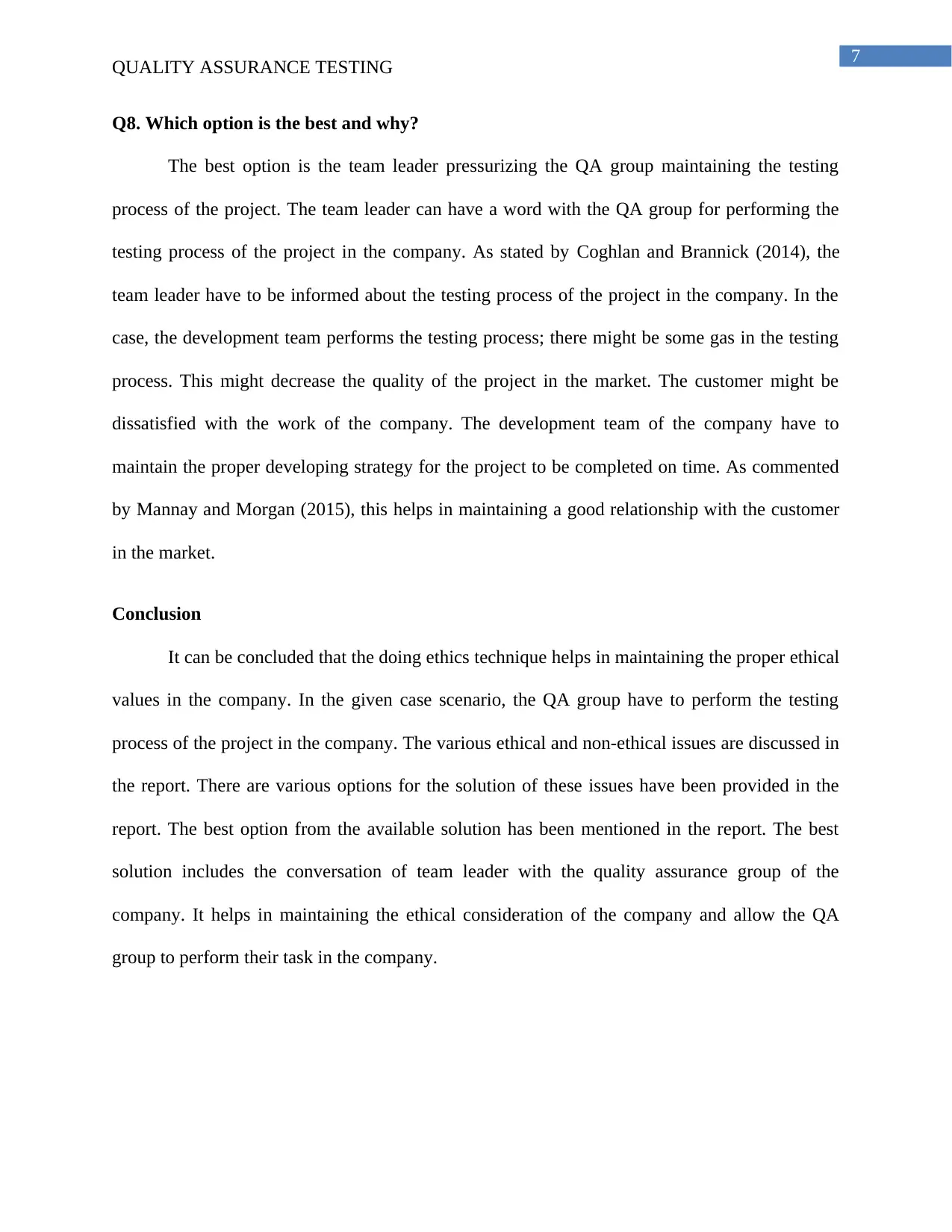
7
QUALITY ASSURANCE TESTING
Q8. Which option is the best and why?
The best option is the team leader pressurizing the QA group maintaining the testing
process of the project. The team leader can have a word with the QA group for performing the
testing process of the project in the company. As stated by Coghlan and Brannick (2014), the
team leader have to be informed about the testing process of the project in the company. In the
case, the development team performs the testing process; there might be some gas in the testing
process. This might decrease the quality of the project in the market. The customer might be
dissatisfied with the work of the company. The development team of the company have to
maintain the proper developing strategy for the project to be completed on time. As commented
by Mannay and Morgan (2015), this helps in maintaining a good relationship with the customer
in the market.
Conclusion
It can be concluded that the doing ethics technique helps in maintaining the proper ethical
values in the company. In the given case scenario, the QA group have to perform the testing
process of the project in the company. The various ethical and non-ethical issues are discussed in
the report. There are various options for the solution of these issues have been provided in the
report. The best option from the available solution has been mentioned in the report. The best
solution includes the conversation of team leader with the quality assurance group of the
company. It helps in maintaining the ethical consideration of the company and allow the QA
group to perform their task in the company.
QUALITY ASSURANCE TESTING
Q8. Which option is the best and why?
The best option is the team leader pressurizing the QA group maintaining the testing
process of the project. The team leader can have a word with the QA group for performing the
testing process of the project in the company. As stated by Coghlan and Brannick (2014), the
team leader have to be informed about the testing process of the project in the company. In the
case, the development team performs the testing process; there might be some gas in the testing
process. This might decrease the quality of the project in the market. The customer might be
dissatisfied with the work of the company. The development team of the company have to
maintain the proper developing strategy for the project to be completed on time. As commented
by Mannay and Morgan (2015), this helps in maintaining a good relationship with the customer
in the market.
Conclusion
It can be concluded that the doing ethics technique helps in maintaining the proper ethical
values in the company. In the given case scenario, the QA group have to perform the testing
process of the project in the company. The various ethical and non-ethical issues are discussed in
the report. There are various options for the solution of these issues have been provided in the
report. The best option from the available solution has been mentioned in the report. The best
solution includes the conversation of team leader with the quality assurance group of the
company. It helps in maintaining the ethical consideration of the company and allow the QA
group to perform their task in the company.
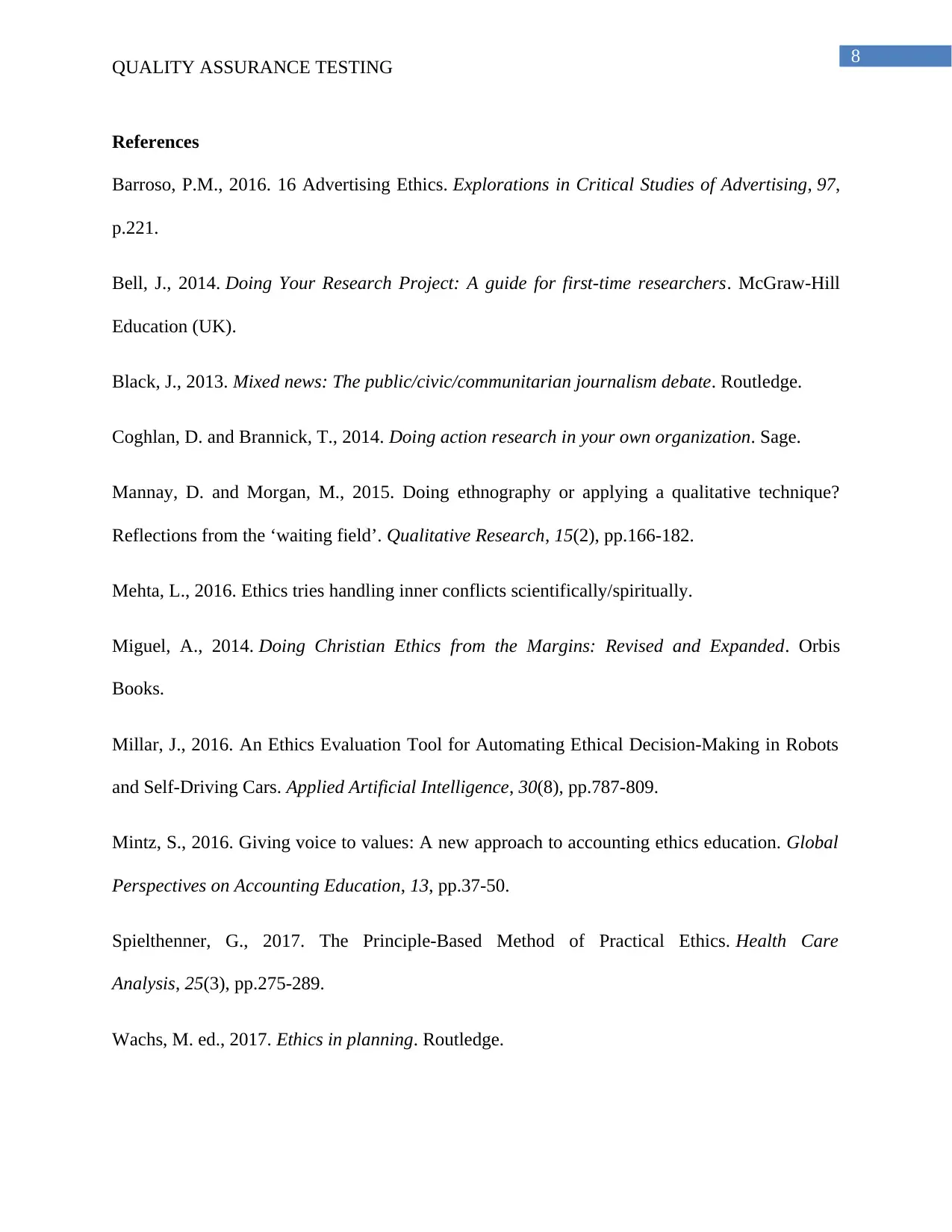
8
QUALITY ASSURANCE TESTING
References
Barroso, P.M., 2016. 16 Advertising Ethics. Explorations in Critical Studies of Advertising, 97,
p.221.
Bell, J., 2014. Doing Your Research Project: A guide for first-time researchers. McGraw-Hill
Education (UK).
Black, J., 2013. Mixed news: The public/civic/communitarian journalism debate. Routledge.
Coghlan, D. and Brannick, T., 2014. Doing action research in your own organization. Sage.
Mannay, D. and Morgan, M., 2015. Doing ethnography or applying a qualitative technique?
Reflections from the ‘waiting field’. Qualitative Research, 15(2), pp.166-182.
Mehta, L., 2016. Ethics tries handling inner conflicts scientifically/spiritually.
Miguel, A., 2014. Doing Christian Ethics from the Margins: Revised and Expanded. Orbis
Books.
Millar, J., 2016. An Ethics Evaluation Tool for Automating Ethical Decision-Making in Robots
and Self-Driving Cars. Applied Artificial Intelligence, 30(8), pp.787-809.
Mintz, S., 2016. Giving voice to values: A new approach to accounting ethics education. Global
Perspectives on Accounting Education, 13, pp.37-50.
Spielthenner, G., 2017. The Principle-Based Method of Practical Ethics. Health Care
Analysis, 25(3), pp.275-289.
Wachs, M. ed., 2017. Ethics in planning. Routledge.
QUALITY ASSURANCE TESTING
References
Barroso, P.M., 2016. 16 Advertising Ethics. Explorations in Critical Studies of Advertising, 97,
p.221.
Bell, J., 2014. Doing Your Research Project: A guide for first-time researchers. McGraw-Hill
Education (UK).
Black, J., 2013. Mixed news: The public/civic/communitarian journalism debate. Routledge.
Coghlan, D. and Brannick, T., 2014. Doing action research in your own organization. Sage.
Mannay, D. and Morgan, M., 2015. Doing ethnography or applying a qualitative technique?
Reflections from the ‘waiting field’. Qualitative Research, 15(2), pp.166-182.
Mehta, L., 2016. Ethics tries handling inner conflicts scientifically/spiritually.
Miguel, A., 2014. Doing Christian Ethics from the Margins: Revised and Expanded. Orbis
Books.
Millar, J., 2016. An Ethics Evaluation Tool for Automating Ethical Decision-Making in Robots
and Self-Driving Cars. Applied Artificial Intelligence, 30(8), pp.787-809.
Mintz, S., 2016. Giving voice to values: A new approach to accounting ethics education. Global
Perspectives on Accounting Education, 13, pp.37-50.
Spielthenner, G., 2017. The Principle-Based Method of Practical Ethics. Health Care
Analysis, 25(3), pp.275-289.
Wachs, M. ed., 2017. Ethics in planning. Routledge.
⊘ This is a preview!⊘
Do you want full access?
Subscribe today to unlock all pages.

Trusted by 1+ million students worldwide
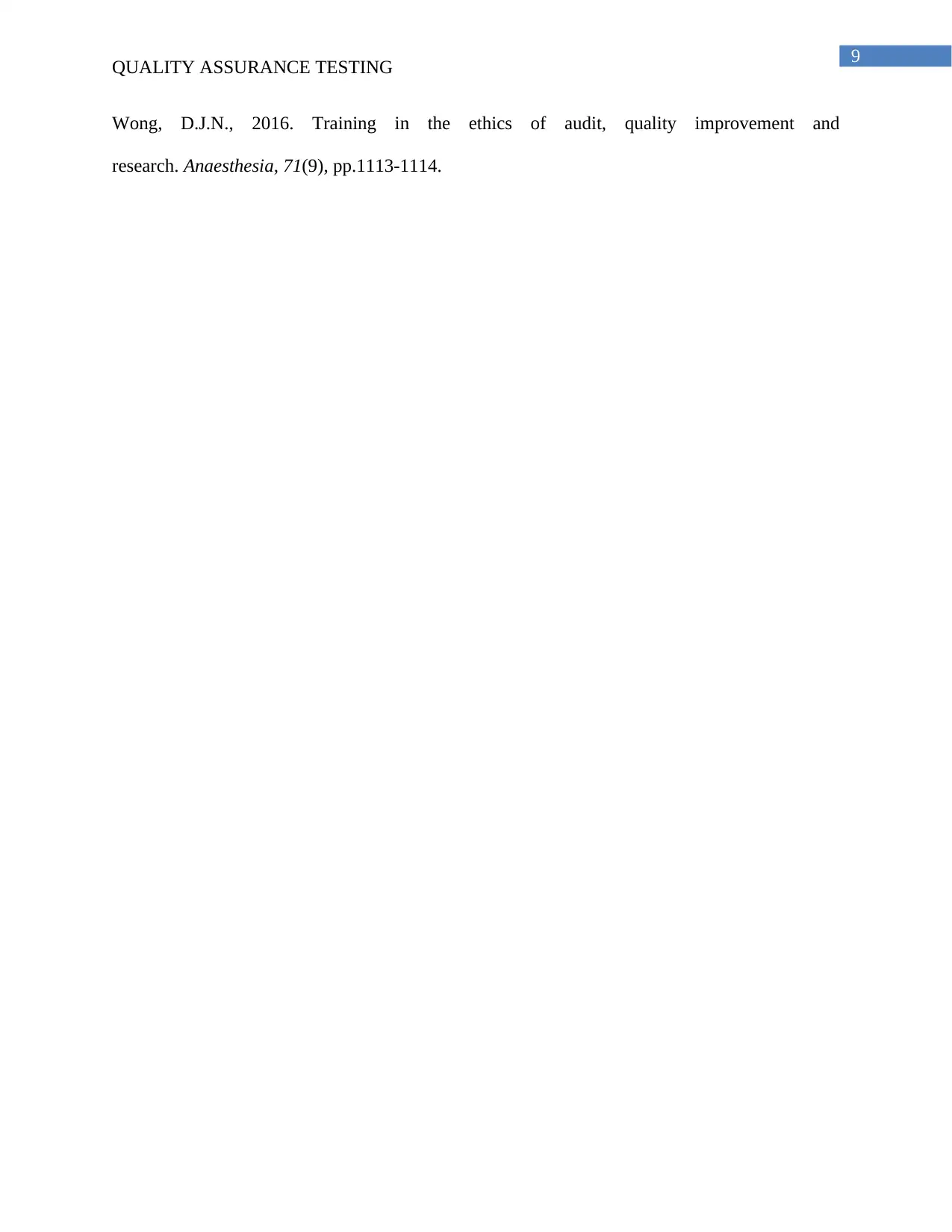
9
QUALITY ASSURANCE TESTING
Wong, D.J.N., 2016. Training in the ethics of audit, quality improvement and
research. Anaesthesia, 71(9), pp.1113-1114.
QUALITY ASSURANCE TESTING
Wong, D.J.N., 2016. Training in the ethics of audit, quality improvement and
research. Anaesthesia, 71(9), pp.1113-1114.
1 out of 10
Related Documents
Your All-in-One AI-Powered Toolkit for Academic Success.
+13062052269
info@desklib.com
Available 24*7 on WhatsApp / Email
![[object Object]](/_next/static/media/star-bottom.7253800d.svg)
Unlock your academic potential
Copyright © 2020–2025 A2Z Services. All Rights Reserved. Developed and managed by ZUCOL.





